
If you haven't made the upgrade to 4K yet, we've got news for you. You're too late. The cutting edge has moved on already. The Philips Brilliance 275P4VYKEB is one of the newest 5K screens to hit the market. Although Apple's iMac had a 5K version a while back, and Dell got there some time ago too (see the KitGuru review HERE), this is my first look at a 5K screen, and it's not as expensive as you might think.
Like Dell's original offering, the 275P4VYKEB is a 27in TFT with 5,120 x 2,800 pixels. Putting that in perspective, it has exactly four times as many pixels as AOC's AGON AG271QX, with the same screen diagonal. That's a pretty hefty number of pixels, and actually beyond what many graphics cards can drive. In fact, to use the full 5K this screen needs two DisplayPort connections to the same graphics card, and only a handful of cards are currently supported officially, although we suspect many more will work.
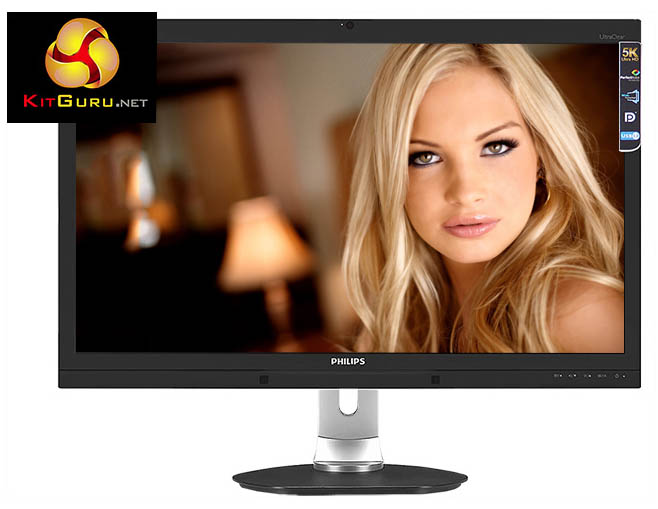
Other than the headline 5K resolution, this is a fairly standard screen in terms of its other specifications. It uses PLS technology, which is Samsung's propriety spin on IPS, and has broadly similar features to IPS, including a wide viewing angle, but also a relatively slow pixel response compared to TN. The 275P4VYKEB has a 8ms response time, which is pretty slow compared to the 1ms TN panels that are readily available.
There is also no high-frequency refresh to boast about, with the panel maxing out at 60Hz whether in 5K or 4K modes. The 1000:1 contrast and 300cd/m2 brightness rating are bog standard too. You do get a three-port USB 3.0 hub built in, headphone jack, stereo 2W speakers and even a 2Mpixel webcam with microphone (presumably taking the fourth USB port).
So this is possibly more of a business and content creation screen than one for ardent gamers. It's clearly all about that mega pixel count, which is pretty darned amazing. So let's find out if this 5K monster is special K or just OK.
Specification:
Screen size: 27-inch, 16:9 aspect
Native resolution: 5,120 x 2,880
Refresh rate: 60Hz
Panel type: PLS
Contrast ratio: 1000:1 (typical)
Brightness: 300cd/m2
Response time: 8ms
Display inputs: 2 x DisplayPort 1.2
USB hub: Yes (3 x USB 3.0)
Tilt: Yes
Raise: Yes
Swivel: Yes
Other: Headphone jack, 2 x 2W speakers, 2Mpixel webcam with microphone.
Retail Price: £737.88 (inc. VAT)
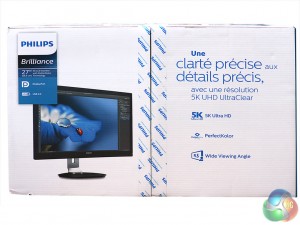
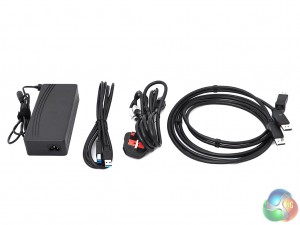
The 275P4VYKEB doesn't come with a lot in the box – just the power supply, a USB cable, and two DisplayPort cables. The latter are the most interesting inclusion, because they are permanently attached to each other, and for a reason. Both are required to provide enough bandwidth for 5K. A single DisplayPort cable will only be enough for 4K. According to the screen's manual, the only graphics cards supported are the NVIDIA GeForce GTX980 plus Quadro K2200, K4200 and K5200.
We suspect that any models later than these in the same range position will do too, and there will be some AMD cards that work as well. But you should check with Philips before buying this screen, to avoid wasting your money on just 4K.
The 275P4VYKEB is a rather sober black, with just a little bit of silver on the stand. The arm screws into the base, and then the screen simply slots onto the arm.
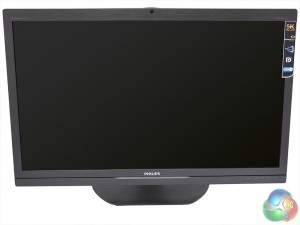
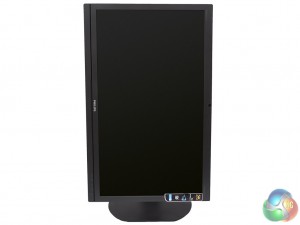

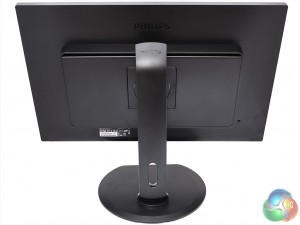
The screen provides all the usual adjustment possibilities, with 150mm of height adjustment, 65 degrees of swivel in either direction, tilting 20 degrees backwards or 5 degrees forward, and the ability to pivot 90 degrees into portrait mode.
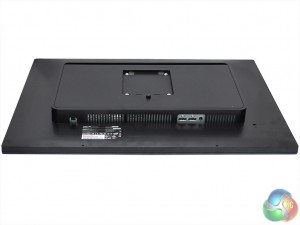
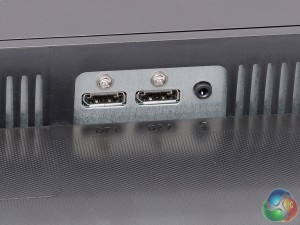
Apart from the power connection, there are only two DisplayPorts on this screen, and you will need to use both for 5K. This is essentially a screen meant to be attached to just one system at a time. Dell's 5K model also includes a MiniDisplayPort, which would have been a handy utility here.
The upstream USB 3.0 port and three downstream ports are placed reasonably accessibly on the side, although they are recessed quite a bit so you will need to reach around the bezel to get to them. We suspect that the fourth USB downstream is taken for the next feature up for discussion:
Aside from a pair of 2W speakers that are invisibly integrated, there's a 2Mpixel webcam on the top of the bezel, with microphone pinholes either side.
The on-screen display (OSD) menu is operated by a series of innocuous buttons in the bottom right corner of the bezel.
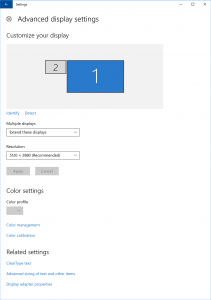
As a taster of just how massive a 5K screen's pixel count is, here it is compared to a Dell 24in screen sporting a not unreasonable 1,920 x 1,200. The 5K screen clearly dwarfs the 2K one. Fortunately, even in a highly disproportionate multi-screen setup like this, Windows 10 handles things pretty well, scaling windows as you move them between displays based on which one they are currently mostly in. So even though the Philips has an unfeasible level of detail, text remains readable and menu elements are small but not ridiculously so.
The four menu operation buttons also offer rapid access to a few often-used functions. The buttons themselves are touch-sensitive. Their location is pretty hard to see in poor room lighting, and they also require a certain knack to operate successfully.
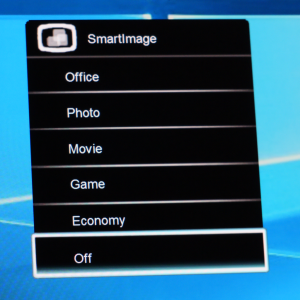
The leftmost button calls up a quick menu where you can choose between the SmartImage presets, which cover a pretty comprehensive range of regular computing activities.

Next along, a volume control for the built-in speakers.

The next button enables a separate brightness control.
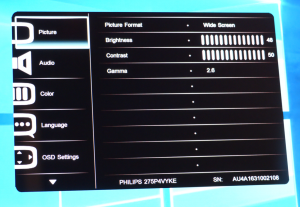
The third button along calls up the main menu, which always defaults to the Picture screen. This provides controls over Picture Format – Wide Screen or 1:1 – as well as Brightness and Contrast. There's a Gamma setting with five options, from 1.8 to 2.6. The default is 2.2, right in the middle.
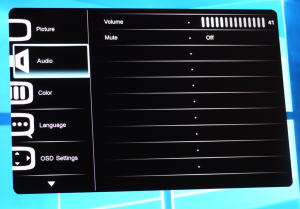
There's not much in the Audio section – just another way to access the volume control and the option to mute all sound.
In the Color section you can choose a Color Temperature preset in Kelvin, or presets for Adobe RGB and sRGB, or use red, green and blue sliders to configure a user-defined colour profile.
You can choose between many options for the OSD language.
There's not much on offer when it comes to OSD settings. You can't, for example, change the location of the OSD on the screen.
Not much going on in Setup either. You can choose to turn the USB hub off and on, reset everything to default, and call up screen information.
Overall, there's enough in the OSD for the intended market. Since this isn't really a gaming screen, you wouldn't expect any particular features for this kind of user, and indeed there's just the gaming SmartImage preset. But you good have good control over image quality for more serious applications. Overall, the options are good, if not exceptional.
Our main test involves using a DataColor Spyder Elite 5 Colorimeter to assess a display’s image quality. The device sits on top of the screen while the software generates colour tones and patterns, which it compares against predetermined values to work out how accurate the screen is.
The results show –
- A monitor’s maximum brightness in candelas or cd/m2 at various levels set in the OSD.
- A monitor’s contrast ratio at various brightness levels in the OSD.
- The brightness deviation across the panel.
- The black and white points
- The colour accuracy, expressed as a Delta E ratio, with a result under 3 being fine for normal use, and under 2 being great for colour-accurate design work.
- The exact gamma levels, with a comparison against preset settings in the OSD.
We first run this test with the display in its default, out-of-the-box state, with all settings on default. We then calibrate the screen using the Spyder software and run the test again.
We always test the display subjectively on the Windows desktop, using it for general tasks such as browsing and word processing, and with games as well, even if the display is not intended solely for that purpose. We pay careful attention to any artefacts, ghosting or motion blur, and enable any gaming specific features, such as adaptive-sync settings like G-Sync, using a compatible graphics card in our test PC.
In the case of the Philips, we performed the primary testing at the native 5K resolution in Off SmartImage preset mode. We also left the monitor at 60Hz (not that there were other options in this case). Our test system was equipped with an NVIDIA Quadro K2200, which is on the list as supporting 5K with this screen, a claim we found to be entirely true.
First off, the uncalibrated results show an amazing gamut, with 100 per cent sRGB coverage and a superb 98 per cent Adobe RGB. You really will be able to see ever colour nuance with this monitor.
On the other hand, the panel's brightness uniformity is merely mediocre. The bottom left-hand corner is a particular worry.
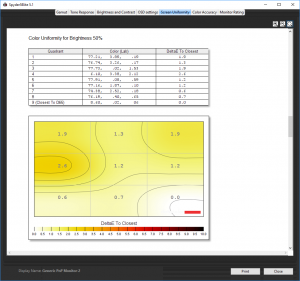
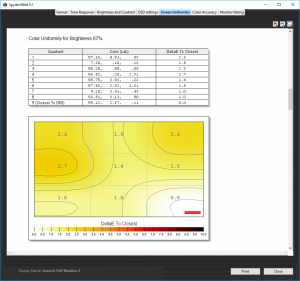
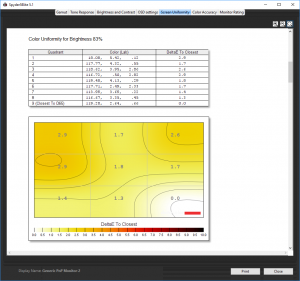
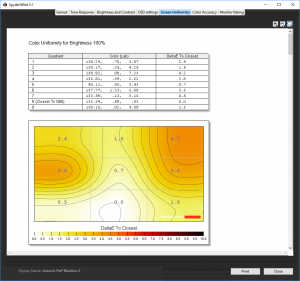
Fortunately, colour uniformity is much better, and in fact one of the most uniform we have seen.
Even at 100 per cent brightness, the recorded level is noticeably behind the 300cd/m2 specifiction. Contrast is also quite a bit off the stated 1000:1, although it is also reassuringly uniform above the 50 per cent brightness level, which is the range you will most likely be using. Colour temperature is similarly reasuringly stable, getting slightly warmer at 75 per cent and above but not noticeably so.
The Philips provides a decent variety of presets for common usage scenarios, and these are quite different in their characteristics. We performed our other tests with the Off preset, and the default brightness, which is 100 per cent. The Office preset drops the brightness down noticeably, but maintains the same contrast and only a slightly cooler white point. The Photo preset is identical to Off with 100 per cent brightness, but the Movie setting bumps up brightness so that it exceeds the rated 300cd/m2, alongside a noticeably pronounced contrast and much cooler colour temperature. The Game preset is similar to Movie, but with even more brightness but warmer colours. The Economy preset drops the brightness right down, as well as the contrast, but with the warmest colours of all.
The recorded gamma for each of the five gamma modes is pretty much exactly 0.1 over what Philips says it's supposed to be, except for Gamma 2.6 where it's even more wide of the mark at 2.8. With such consistency, though, it's surprising that these are not spot on. Philips could have just dialled things down by 0.1 in every case for a perfect score.
Uncalibrated, the Phlips achieves a reasonable colour accuracy of 3.26. This is somewhere in the middle of the pack
Next we calibrated the screen using the Spyder to see if this could improve matters.
The colour gamut is just as excellent as before, with 100 per cent of sRGB visible, and 98 per cent of AdobeRGB.
The Gamma level at 2.2 is still 2.3, so no improvement here.
Colour accuracy is markedly better to 2.09, which is now a very respectable performance.
Overall, the positive aspects outweigh the negative, with very good colour accuracy, good colour uniformity, and a truly excellent gamut, versus less stellar brightness uniformity and gamma presets that are a little understated from their true values. The huge amount of detail is the real benefit, though, which none of these tests assess. The quality of high-resolution content such as digital photos is very much evident. Once you have seen images in this kind of glory it's hard to go back to lower-resolution screens.
The Philips Brilliance 275P4VYKEB 5K Monitor may not have aced every test, but it's still a pretty amazing bit of kit. It has good colour accuracy and uniformity, and a near-perfect gamut. It isn't the perfect partner for high-resolution gaming, but looking at photos in this kind of resolution is a revelation. Windows 10 also copes with the scaling of text admirably, even when using a second screen of much lower resolution alongside.
The slightly off gamma ratings and mediocre brightness uniformity are really the only notable downsides. The fact you need to use both DisplayPort inputs for 5K is more like an occupational hazard of this resolution, although it would have been nice to have another input in case you do need to hook up a secondary device.
The menu doesn't have the range of detailed adjustment that more gaming-focused screens are offering, and the screen only runs at 60Hz, but there's enough configurability for the more serious user. There are presets for most everyday business and entertainment activities, plus manual adjustments that can successfully improve colour accuracy.
The Philips Brilliance 275P4VYKEB 5K Monitor is available on Overclockers UK. Some Amazon third party sellers have the monitor at £737 but we have been told that there is an EAN pricing mistake and the correct price is £1199 inc vat. This is a pretty expensive 27in screen, but when you consider that you're getting four times the resolution that a lot of TFTs this size offer, it doesn't seem particularly outrageous, particularly when Dell's equivalent is £100 more. If you want to stay ahead of the curve and feel like larging it when it comes to screen pixels, this is a tasty proposition.
Discuss on our Facebook page, over HERE.
Pros:
- Stunning 5K (5,120 x 2,880) resolution.
- Near-total colour gamut.
- Great colour uniformity.
- Good colour accuracy.
- USB 3.0 hub.
- Presets for a variety of uses.
- Built-in webcam and mic.
Cons:
- Gamma presets are slightly off their official rating.
- Mediocre brightness uniformity.
- 5K connection only supports one input.
Kitguru Says: The Philips Brilliance 275P4VYKEB 5K Monitor takes detail to a new level, with great colour and a price that's not as much as you would expect.
 KitGuru KitGuru.net – Tech News | Hardware News | Hardware Reviews | IOS | Mobile | Gaming | Graphics Cards
KitGuru KitGuru.net – Tech News | Hardware News | Hardware Reviews | IOS | Mobile | Gaming | Graphics Cards


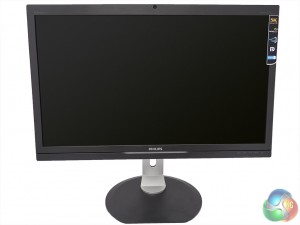
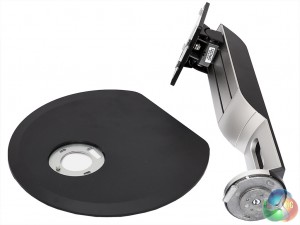
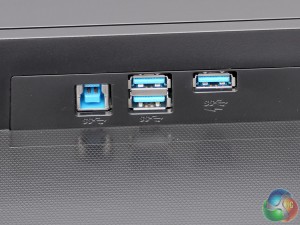
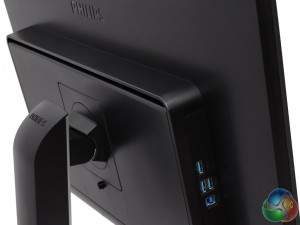
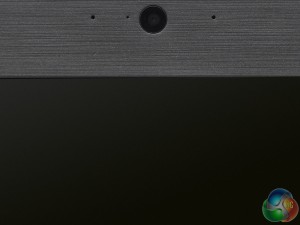

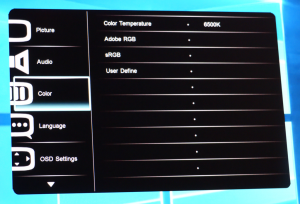
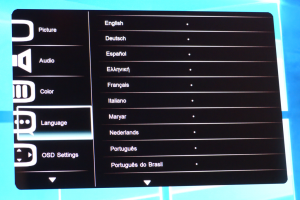
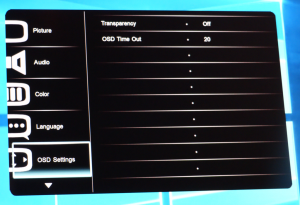
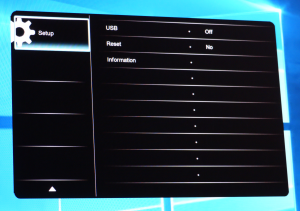
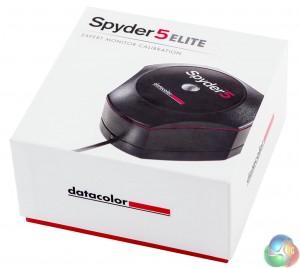
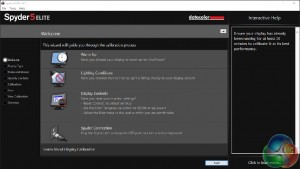



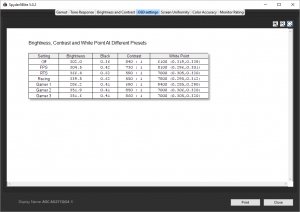
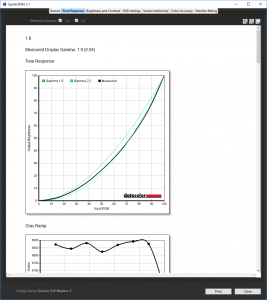
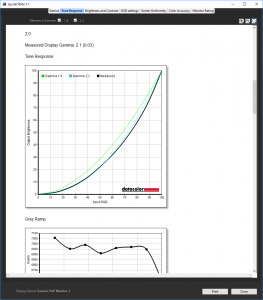
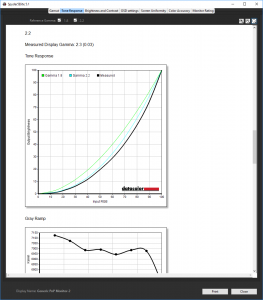
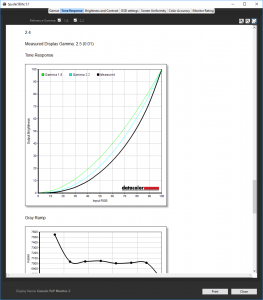
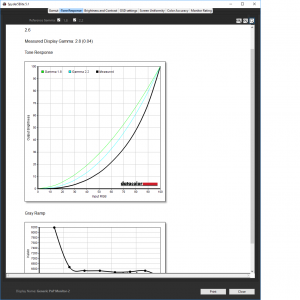
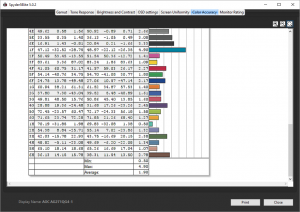






Is the picture on the monitor from a porn scene?
No, its not. get your mind out of the gutter !
It definitely is.
No freesync or G-sync?
And what’s with that response time??
It won’t sell if it’s expensive. So it’s rather cheap. XD
Google is paying 97$ per hour! Work for few hours and have longer with friends & family! !mj95d:
On tuesday I got a great new Land Rover Range Rover from having earned $8752 this last four weeks.. Its the most-financialy rewarding I’ve had.. It sounds unbelievable but you wont forgive yourself if you don’t check it
!mj95d:
➽➽
➽➽;➽➽ http://GoogleFinancialJobsCash95DirectSourceGetPay$97Hour… ★★✫★★✫★★✫★★✫★★✫★★✫★★✫★★✫★★✫★★✫★★✫★★✫★★✫★★✫★★✫★★✫★★✫★★::::::!mj95d:….,…..
That’s my wife you’re talking about there.
1 yr ago I decided to abandon my last work and that decision changed everything for me… I started freelancing at home, for this company I stumbled upon over internet, for several hours every day, and I earn much more than i did on my old job… Last paycheck i got was for $9k… Great thing about this job is that i have more free time for my loved ones… CHILP.IT/728813e
Yep.. It is!
Problem is, that screens are getting bigger pixel counts, way before GPU’s can actually provide them with anything close to 60Hz. This is certainly not a gaming monitor with a mediocre response rate (in gaming monitor terms) and a 60Hz refresh rate. Also, have you seen the difference between 4K and 5K? Your eyesight would have to be so acute to be able to tell the difference. And even then, I would question that a difference could be seen. Where the technology needs to develop is in OLED screens, but it still seems pretty embryonic with getting the picture to last more than a few years. Bottom line is… There is so much better out there, that will give so much more than just pixel count.
I’ve probably mentioned this before but any chance you can try the screens in half and quarter resolution to see how they look out of native? In this case 2560 x 1440 and 1280 x 720. Input lag doesn’t matter with the types of games I play but many (especially the older ones) dont allow you to scale the GUI so on a 4k/5k screen of this size they’d be unreadable. Apparently there is some variation in the visual performance of monitors out of native, unfortunately no reviewers ever test for it 🙁
I have this Monitor and it has 1 Big problem! It’a not really Flicker-Free!
I bought it after verifying on Phillips product page;
http://www.philips.co.uk/c-p/275P4VYKEB_00/brilliance-5k-lcd-monitor-with-perfectkolor
But l found out that any brightness less then 100% you get Flicker because it uses PWM to control the brightness, so it’s not very comfortable for you eyes. It could be great review if you could mention it :-(.
You can see the horizontal waves in the attached photo I took now.
P.S – there is no SmartUniformity option in the OSD menu!
https://uploads.disquscdn.com/images/63486a88011e06fd4c617713443fe7b92273fe5568cc66683e01b6104a35302d.jpg